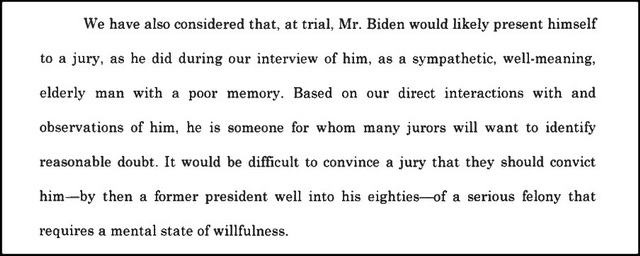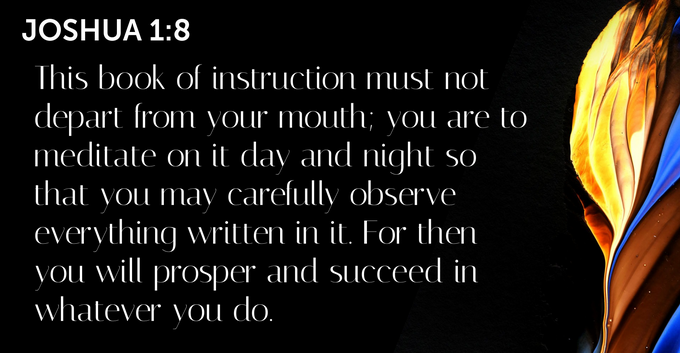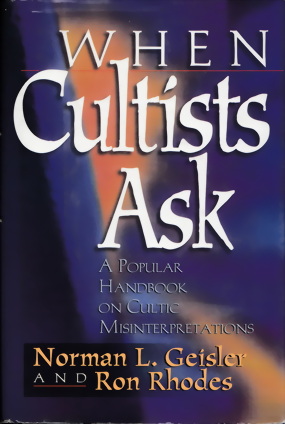An elderly man with a poor memory. Great video by @WesternLensman
Author: Papa Giorgio


Michael Rapaport Says Media Lied About Trump’s Charlottesville Statement
Actor Michael Rapaport has admitted that he helped spread the left’s Trump Charlottesville “very fine people” hoax, saying he was “wrong” to have promoted the lie.
- “One thing about the Charlottesville — that I ranted about, and I was wrong. When you see the full quote, that wasn’t what he said.” (BREITBART | RIGHT SCOOP | DAILY CALLER)
And so I combine that with more — below, this should be married to my larger post:
LANGUAGE WARNING!

CNN is fact checking Biden? Woah
TWITCHY has more on this:
As we told you earlier, you know it’s bad for Biden when even CNN is unable to carry his water anymore, but now the cable net’s fact-checker has, to his credit, decided not to ignore the doozies the president told last evening.
Today the White House trotted out Biden WH adviser and super-weasel Ian Sams to tell more whoppers and pretend Biden didn’t tell any lies during his spin session about allegations of senility and storing classified documents in his garage.
This is a pretty brutal takedown of Biden’s BS from last night, and coming from CNN it’s got to be fairly alarming for the White House press office to see….

DOJ Says Biden Too Senile To Stand Trial, WH Objects
AN UPDATED EXAMPLE:
- Biden denied mental incompetence. “I know what the hell I’m doing,” he proclaimed at the event. His memory is fine. The windmills of his mind are spinning in good order. His confusion of the president of Egypt with the president of Mexico tended to belie his assertion. (POWERLINE | RED STATE | TWITCHY [Techno-Fog])
It’s not conspiracy to ask questions about Biden’s “mistakes” (more at RIGHT SCOOP):
Here is a challenge regarding this video from a comment on my site’s Facebook Page:
SUE F. SAID
- Like Trump is any better, Trump has days where he believes that he beat Obama in 2016. They’re both old & mentally declining…check yourself!
I respond (with an EXTRA addition here, at the end). For those unaware, POST MILLENNIAL’s headline and sub-title explain:
BREAKING: Biden’s DOJ says evidence shows President ‘willfully’ withheld classified docs—but he will not be prosecuted: The special counsel’s report said Biden’s memory “was significantly limited” during the 2023 interviews with Hur
SUE F., I wish to note that the DOJ has agreed with me and not with you. What do I mean? Here is a Tweet and a pic of the official report:
- they [DOJ] said he [Biden] was too old and decrepit [memory loss] in 2015 for a jury to think he could have knowingly and willingly done these actions [kept top secret documents].
Are they dropping the same charges against Trump for the same reasons? No. You want to know why? Because he [Trump] has a good grasp on reality and a good memory. Trump doesn’t “Spins Yarns That Often Unravel” – as the New York Times says of Biden. Like,
- Taught Classes At The University Of Pennsylvania;
- Visited Ground Zero Day After 9/11;
- Half his House ‘Almost Collapsed’ After a Fire;
- House Burn Down with My Wife In It — She Got Out Safely;
- Claims He Convinced Strom Thurmond To Support The Civil Rights Act;
- He Began Career as Civil Rights Activist;
- Saw Pittsburgh Bridge Collapse;
- Ended Cancer;
- Appointed To The [U.S. Naval] Academy In 1965;
- Son Died in Iraq;
- He Formed the Quad Alliance;
- Born in the Same Hospital Where His Grandfather Died;
- Was ‘Involved’ in Civil Rights Movement;
- Went to a Black Church as a Teen;
- Biden Says He Attended HBCU;
- Biden Claims He Has Cancer (“That’s why I and so damn many other people I grew up [with] have cancer”);
- Wrote Law Review Articles About Right to Privacy (claimed he had written “a number of law review articles” about the right to privacy referenced in the now-overturned Roe v. Wade decision)
- Was A ‘Full Professor’ At The University Of Pennsylvania;
- Grandfather Died In The Hospital I Was Born In Six Days Before He Was Born;
- Offered A Job by An Idaho Lumber Company;
- Used To Drive An 18-Wheeler;
- Visited Pittsburgh’s Tree of Life Synagogue After The 2018 Massacre;
- Chatted With an Amtrak Conductor in His Seventh Year As Vice President, When The Guy Retired 15 Years Before;
- Detained By South African Authorities While Trying To Visit Nelson Mandela In Prison In The 1970s.
Etc., Etc., Etc. I left out the many political lies because all politicians try to spin the economy, inflation, debt, etc. I chose those because they are lies that show cognitive dissonance. Even after staff telling him to zip it this stuff never happened, he told some again months down the road.
- Prosecutors Decline To Charge ‘Elderly’ Biden Over ‘Poor Memory’ (FEDERALIST)
- Hur’s Report: Biden Ready For Memory Care (POWERLINE)
- Special Counsel Finds Biden Is Too Damn Old to Be Charged in Classified Docs Scandal (PJ-MEDIA)
- Biden Lawyers Demand Revisions to Hur Report, Claim Descriptions of His ‘Limited Recall’ Are Inflammatory (RED STATE)
- WH Lawyers Sent Special Counsel This Letter Asking Him to Revise the ‘Biden’s Senile’ Section (TWITCHY)
- BREAKING: White House demanded Special Counsel CHANGE his report over Biden’s mental fitness (RIGHT SCOOP)
- ‘Well-Meaning Elderly Man’: Republicans Seize On Biden Memory Issues Detailed In Hur Report (WASHINGTON TIMES)
SUE F. COUNTERS:
- I’m not part of your brainwashed propaganda group here, the weak minded grasp on to leaders like you & Trump. Trumps mind has been mentally declining due to the stress of losing his trials & millions, but he thanks people like you for paying his legal fees. A billionaire panhandling the weak for jingle… you just gotta love it! Be sure to donate to him…
I RESPOND:
- Perfect ad hominem attack. I would expect no different from either an atheist activist or a progressive one.
EXTRA!
Just a little leaven to deflate SUE F.’S argument:
A cut and spliced clip. Why am I not surprised by you pathetic losers. It about the same shitty quality as the photoshopped video of Lauren Boebert.
— Danny Autry (@jdannyautry) September 17, 2023
What was actually said. He was talking about beating the Obama division by beating Hillary and even went on to say how he has changed what he calls Hillary as Joe Biden now has the “crooked” nickname. pic.twitter.com/KvpBEYQNSI
— Jessico Bowman (@JessicoBowman) September 17, 2023
Well, at least President Biden is “a president for everybody, whether you live in a red state or a green state.” (POST MILL X)

Dennis Touches Quickly On The Super Bowl’s National Anthems
You can see my old posts on this (more videos):
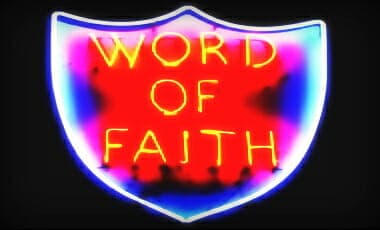
FAULTY DOCTRINE (Hippity Hoppity)
Originally posted April of 2013, UPDATED with the NET Bible and commentary at the end.
Here is a quick 101 on the history of the Word Faith via GOT QUESTIONS:
The Word of Faith movement grew out of the Pentecostal movement in the late 20th century. Its founder was E. W. Kenyon, who studied the metaphysical New Thought teachings of Phineas Quimby. Mind science (where “name it and claim it” originated) was combined with Pentecostalism, resulting in a peculiar mix of orthodox Christianity and mysticism. Kenneth Hagin, in turn, studied under E. W. Kenyon and made the Word of Faith movement what it is today. Although individual teachings range from completely heretical to completely ridiculous, what follows is the basic theology most Word of Faith teachers align themselves with.
At the heart of the Word of Faith movement is the belief in the “force of faith.” It is believed words can be used to manipulate the faith-force, and thus actually create what they believe Scripture promises (health and wealth). Laws supposedly governing the faith-force are said to operate independently of God’s sovereign will and that God Himself is subject to these laws. This is nothing short of idolatry, turning our faith—and by extension ourselves—into god.
From here, its theology just strays further and further from Scripture: it claims that God created human beings in His literal, physical image as little gods. Before the fall, humans had the potential to call things into existence by using the faith-force. After the fall, humans took on Satan’s nature and lost the ability to call things into existence. In order to correct this situation, Jesus Christ gave up His divinity and became a man, died spiritually, took Satan’s nature upon Himself, went to hell, was born again, and rose from the dead with God’s nature. After this, Jesus sent the Holy Spirit to replicate the Incarnation in believers so they could become little gods as God had originally intended.
Following the natural progression of these teachings, as little gods we again have the ability to manipulate the faith-force and become prosperous in all areas of life. Illness, sin, and failure are the result of a lack of faith, and are remedied by confession—claiming God’s promises for oneself into existence. Simply put, the Word of Faith movement exalts man to god-status and reduces God to man-status. Needless to say, this is a false representation of what Christianity is all about. Obviously, Word of Faith teaching does not take into account what is found in Scripture. Personal revelation, not Scripture, is highly relied upon in order to come up with such absurd beliefs, which is just one more proof of its heretical nature.
[….]
The Word of Faith movement is deceiving countless people, causing them to grasp after a way of life and faith that is not biblical. At its core is the same lie Satan has been telling since the Garden: “You shall be as God” (Genesis 3:5). Sadly, those who buy into the Word of Faith movement are still listening to him. Our hope is in the Lord, not in our own words, not even in our own faith (Psalm 33:20-22). Our faith comes from God in the first place (Ephesians 2:8; Hebrews 12:2) and is not something we create for ourselves. So, be wary of the Word of Faith movement and any church that aligns itself with Word of Faith teachings.
Here is an example of one verse striped of context via the Word Faith movement:
JOSHUA 1:8—Is this verse a key to financial prosperity, as Word-Faith teachers suggest?
MISINTERPRETATION: Joshua 1:8 says, “This book of the law shall not depart from your mouth, but you shall meditate on it day and night, so that you may be careful to do according to all that is written in it; for then you will make your way prosperous, and then you will have success” (NASB). Word-Faith teachers say this verse is a key to financial prosperity.
CORRECTING THE MISINTERPRETATION: Word-Faith teachers are reading a meaning into this verse that is not there. The context of this verse is military, not financial. In fact, finances are nowhere in sight in this entire chapter of Joshua.
In the conquest of the Promised Land, God promised Joshua that his military efforts would prosper if he maintained his commitment to meditate upon and obey God’s Word. The prospering also no doubt includes the full outworking of the land promises that were given unconditionally by God in the Abrahamic Covenant (Gen. 12:1-3). Later, just before his death, Joshua urged the people to continue living in submission to the Scriptures (Josh. 23:6).
What a healthy view of this Joshua verse is this:
… Sometimes we misunderstand what it means, ‘to succeed’ or ‘to prosper’ which has given rise to a prosperity teaching which places the emphasis on temporal, worldly prosperity rather than eternal spiritual wealth. God may choose to bestow worldly wealth on His children or He may permit the alternative, but the goods and chattel of this world are passing away, and like Paul we need to be content in all things.
What is important, is to know the Word of God, to trust the Word of God, and to apply the Word of God in every circumstance of life, knowing that to do so will lead to success in the Christian life; for all things work together for good to those that love the Lord and trust His Word.
We should read, mark, learn, and inwardly digest the Word of the Lord. We should study God’s Book of instruction, particularly those passages that relate specifically to the Church, and we should continually feed on His Word in our hearts by faith with thanksgiving.
We should meditate on His Word, memorize His Word, trust His Word, and love His Word, and we should be sure to obey His Word and apply His Word in our daily lives, for in so doing we will certainly prosper and succeed in all we do, to His praise and glory….
Or s the NET BIBLE rewords a bit:
1:8 This law scroll must not leave your lips! You must memorize it day and night so you can carefully obey all that is written in it. Then you will prosper and be successful.
1:9 I repeat, be strong and brave! Don’t be afraid and don’t panic, for I, the LORD your God, am with you in all you do.”
Biblical Studies Press, The NET Bible First Edition; Bible. English. NET Bible.; The NET Bible (Biblical Studies Press, 2005), Jos 1:7–9.
A decent extended commentary can be found here to help separate the wheat from the Chaff, as competing theologies fight over interpreting verses:
1:6–9. The second half of God’s speech also begins with two imperatives (“Be strong and courageous”), though these two are effectively synonyms. These imperatives follow logically from the promise of verse 5—if no one could resist Joshua, then there was no basis for fear. Instead, as leader he was to distribute the land that God had sworn to give to their ancestors (adapting phrasing found five times in Deuteronomy). The land is thus simultaneously God’s gift and something to be claimed and allotted. Verse 7 provides a more specific focus for Joshua: He was to be strong and very courageous in carefully observing all the instruction (תּוֹרָה) that God had given through Moses. This was not simply a set of facts to be known but rather a life that was to be lived—and living this life would take effort. Drawing on the common metaphor of life as a journey, the idea is that Joshua should stay on the path that this instruction provides rather than take alternative routes, for this is the means by which he would succeed. This success is related to the task that God had given Joshua, so walking faithfully in the Mosaic instruction was the means by which Joshua could lead the people into the land that God had promised.
Joshua was to meditate (הָגָה) on this instruction. The verb, with a similar promise of success, also occurs in Ps 1:2 and means something like “growl” or “mutter.” This verbal element is more apparent in Ps 2:1, where it is translated “plot.” It is difficult to match this word to a single English verb since “meditate” is often thought of as a silent activity. That the instruction was to be in Joshua’s “mouth” is an idiom that goes naturally with the verb. Thus, he would continue reflecting on its meaning, with such reflection being verbal. This relates to the fact that reading in the ancient world meant reading aloud. In the same way, reflection on it was verbal. But what matters in particular is that Joshua’s life was to be shaped by faithfulness to God’s instruction. At this stage in the book we might think of this as unproblematic, but as the ensuing chapters unfold it becomes clear that Joshua would need to wrestle with the intent of the instruction in order to determine how it was to be applied in a range of circumstances. This would require seeing the instruction as guidance for situations that would be faced rather than as a comprehensive set of rules that could simply be applied. Joshua would need a deep knowledge of God’s instruction, which meant both knowing its content and reflecting on how it could be applied. Therefore, it could not depart from his mouth, because only by continued recitation/meditation could he both know it and understand how to apply it. Psalm 1 then broadens out this possibility for all believers.
God’s speech then concludes with a reminder of the command to be strong and courageous so that Joshua would understand there is no place for fear because Yahweh would go with him. Joshua could succeed and lead his people to success when he understood that his role as a leader was to journey with God, know God’s instruction, and shape his life by it. Success here does not mean something financial but to receive the things that God is giving. We might perhaps think of “success” as flourishing in the life God has prepared—which is the way it is developed in Psalm 1. Here, that flourishing would be military, as Israel received the land God gave.
David G. Firth, JOSHUA, ed. T. Desmond Alexander, Thomas R. Schreiner, and Andreas J. Köstenberger, Evangelical Biblical Theology Commentary (Bellingham, WA: Lexham Press, 2021), 72–74.
This from CROSS WISE (2011) explaining a bit about the above:
In light of another Calvary Chapel pastor making an appearance on TBN’s Praise-the-Lord program, I thought it apropos to share a tape in my collection of how a Bible believer should behave when invited onto TBN or any of the other errant “Christian” networks. What sort of message is communicated when a solid Bible teacher shares the platform with heretics and does not bring reproof? Certainly it gives the impression that the guest endorses the teaching of the hosts and /or founder of the Christian network.
Some argue that if they can’t go on TBN due to its corruption, then they couldn’t show up on ABC, NBC or CBS either. They don’t understand the distinction between being salt and light to the unsaved world and practicing biblical separation from so-called Christians who are spreading false teaching against Jesus Christ. To the unsaved, we can use their media to spread the Gospel, but to the errant brother we are to bring correction and divide if they do not stop their false teaching. For a proof-text consider 1 Corinthians 5:11:
But actually, I wrote to you not to associate with any so-called a brother if he is an immoral person, or covetous, or ban idolater, or a reviler, or a drunkard, or a swindler—not even to eat with such a one. (NASB)
When Calvary Chapel Albuquerque’s pastor Skip Heitzig went on TBN last week acting like he and his host Phil Munsey were old friends, it was a shame to the spirit of that passage. Phil Munsey and his brother Steve Munsey are two of the most infamous extortioners in the field of Christian television. Munsey has used new age ideas of paradigm shifts and panentheism to spread his unbiblical dominionist views.
In contrast to the compromisers, the late Walter Martin tried to bring correction the last time he made an appearance on TBN. This video tape has never circulated and has not been available anywhere until now that I have posted it to YouTube.
Back in 1985 my younger sister was Martin’s secretary. She and my older sister and I all regularly attended his weekly Bible study. I used to share my research with him and also with my friend author Dave Hunt. Walter and Dave disagreed on many things regarding their styles of apologetics and discernment. Whenever there was a difference of opinion between the two of them, I usually agreed with Dave.
I had had some discussion with Dr. Martin over Dave’s book, The Seduction of Christianity. Walter had been critical about it on the radio having never read it but based his criticisms upon what his personal editor had told him.
One day my older sister was watching Praise-the-Lord when Hal Lindsey was a guest. He was her pastor at that time. Back then Hal used to challenge the teaching of other TBN regulars and Paul Crouch put up with it. However, that got old with the Crouches and when Hal wouldn’t stop criticizing the Kingdom Now doctrine, he was put on the shelf until he learned to kow-tow to them. When my sister heard Hal bring up Walter’s name in the show, Paul and Jan agreed that he was a brilliant man and Hal said you should have him on some time. They both responded – oh sure we will.
So she informed our little sister who told Walter and Walter told her to call TBN and arrange it which she did. However, the Crouches wouldn’t host him so they got prophecy teacher Doug Clark to do so. My younger sister called me on the day of the taping saying that Walter wanted me to go through Dave Hunt’s book, The Seduction of Christianity and highlight things he would be in agreement with. I was happy to do so for him. He used that information to challenge TBN’s blackballing of Dave Hunt and other whistle-blowers.
I stayed home to work the VCR I didn’t know how to program, while my two sisters attended, one in the green room and one in the audience we had stacked with many friends. Walter gave it to them with both barrels. Not only was the program not replayed at its regular slot, but the tapes were not available when people followed up to request one. Back in those days any Praise-the-Lord program could be bought on audio cassette for a small fee. And both Walter Martin and Doug Clark were never invited back. We had heard years later from Doug Clark that during the interview he kept receiving notes from the stage manager telling him to “shut that guy up” and other nasty notes….

Of Thermostats and Salt n Light | RPT’s Musings
An early morning Bible study and a question from the presenter got me thinking though the idea presented. The question was this:
- if someone had never heard of a thermometer and a thermostat, how would you explain each and differentiate between them? When it comes to us living out our faith, do you think we’re called to be a thermometer or a thermostat?
So I gave my thinking on this question and expand a bit in the video. Enjoy… it is for the strengthening of my fellow believers. Or as Steven Lawson says, it is to get you into an offense mode.
The two articles on business strategy can be found here:
….A thermometer reflects the temperature of the environment. It simply reacts to what’s happening around it. If the temperature is hot, it tells you so. If it’s cold, the thermometer reflects that reality as well. It’s a dumb instrument in the sense it doesn’t contain intelligent, multipurpose functionality. It has one purpose and one purpose only.
A thermostat, on the other hand, regulates the environment. It sets the desired temperature of the room and actively works to maintain it within a given range. If the temperature rises above the goal, the thermostat signals the air conditioner to crank up and cool the room down. If the temperature falls below the goal, the thermostat causes the heater to turn on in order to warm the room up. The thermostat is intelligent in the sense it’s always monitoring the environment, and if the temperature gets too hot or cold, it decides what to do to correct the situation…..
[….]
…A thermometer reads the temperature in a room. If it’s hot in the room, it tells you it is hot in the room. If it is cold in the room, it tells you it’s cold. A thermometer tells you the temperature in the room.
A thermostat regulates the temperature. It helps control the temperature in the room by making small adjustments to heat or cool the room. If it gets too cold in the room, the thermostat adjusts and warms it up. If it gets too hot in the room, the thermostat adjusts and cools it down. It’s all a matter of what temperature you want to set.
The reality is that many leaders, teams and company cultures get stuck in thermometer mode. Their temperature just fluctuates up and down depending on who is in the room or what happens day to day. If it’s cold in a meeting and there is no life in the room, everyone goes cold. If it’s hot in the room and plenty of conflict or drama, everyone gets hot. Day by day their culture is just up and down depending on the temperature of the day.
But, the very best leaders, teams and company cultures operate more in thermostat mode. They are very clear what temperature they are trying to set. They intentionally take time to make sure all on their team understand what type of culture they are trying to create. They are precise with their language, they communicate consistently, and they coach others to understand what temperature they are striving to achieve every day. When it gets too hot in a room, they are able to regulate the temperature back down. When there is no life in a room and it’s way too cold, they are able to breathe life and warmth into the environment….

What Is Fascism? Biden Admin and Amazon Explain
The NATIONAL REVIEW article Dennis Prager is reading from can be found here: “Biden White House Pressured Amazon to Censor Vaccine-Skeptical Books, Internal Emails Reveal” The PRAGER U video mentioned (and the excerpt I included) can be found here: “Big Business & Big Brother”. And the other THOMAS SOWELL video is via this YouTube Channel. Must read JIM JORDAN’S Twitter thread as well.
How biased are these pushes? Mollie Hemingway and Laura Ingraham explain:
‘The Federalist’ editor-in-chief Mollie Hemingway discusses NewsGuard’s global disinformation index categorizing right-leading media outlets as ‘risky’ and left-leaning outlets as ‘least risky’ for disinformation on ‘The Ingraham Angle.’

Teaching Kids How To Think Through The Headlines (Transphobic?)
This is utterly brilliant. A student accuses @jk_rowling of being transphobic. This teacher skillfully dissects the claim and challenges it by asking questions.
He teaches not what to think, but how to think critically.
Watch until the end.
TWITCHY is all in:
…The lawyers in the audience will be very quick to recognize what this is: The Socratic Method. To quote the University of Chicago Law School website on the topic:
Socrates (470-399 BC) was a Greek philosopher who sought to get to the foundations of his students’ and colleagues’ views by asking continual questions until a contradiction was exposed, thus proving the fallacy of the initial assumption. This became known as the Socratic Method, and may be Socrates’ most enduring contribution to philosophy.
In practice, it is not always about finding contradictions, but about exposing assumptions and basically teaching people to literally question everything. Of course, as the old saying goes, you don’t want your mind to be so open your brain falls out, but you should always check your own assumptions.
For instance, applied here, we should note that we have no idea when that video was shot. We aren’t even sure where it was shot, or who was participating. We are sharing it because it has recently gotten attention and it speaks for itself. But we admittedly don’t know much beyond that.
The Socratic Method is also a fun way to drive a person crazy on TSMSFKA Twitter (The Social Media Site Formerly Known As Twitter), Socratically interrogating the positions of leftists and showing how incoherent it is. But it’s also probably why this author is on a lot of leftist block lists. As one TSMSFKA Twitter user noted a while back:
Twitter media account Discussing Film called Harry Potter author a ‘known transphobe’ when reporting on her being made an executive producer on the Harry Potter reboot series. Some people will NEVER stop hating this woman… unless they get sued for defamation, probably.
More info via CLOWNFISH TV:
The controversy surrounding J.K. Rowling and the Discussing Film Twitter account’s labeling of her as a “known transphobe” stems from a series of tweets and public statements made by Rowling over the past few years. These comments have been widely criticized by the transgender community and their allies.
The controversy began with Rowling’s reaction to an article discussing “people who menstruate,” where she seemingly mocked the inclusive language by tweeting, “‘People who menstruate.’ I’m sure there used to be a word for those people. Someone help me out. Wumben? Wimpund? Woomud?” This tweet and subsequent comments by Rowling conflated sex and gender, leading to widespread criticism. She argued that “erasing the concept of sex removes the ability of many to meaningfully discuss their lives” and maintained that “sex is real”.
Rowling has repeatedly stated that she supports transgender rights and that her comments are not meant to be hateful but are rather an expression of her belief in the importance of recognizing biological sex. She has expressed concerns about the impact of “new trans activism” on women’s rights and spaces. However, organizations like GLAAD and Human Rights Campaign have criticized her comments, stating that they target trans people and distort facts about gender identity.
The Discussing Film Twitter account’s reference to Rowling as a “known transphobe” in a tweet about her being an active executive producer on the ‘HARRY POTTER’ series reflects the ongoing controversy surrounding her views on gender and sex. This characterization of Rowling has been supported by some and criticized by others, with various reactions emerging on social media. The backlash and support for the tweet highlight the polarized nature of the debate around Rowling’s comments and their impact on the trans community and broader discussions about gender identity and inclusion.

Patrick Bet-David Exposes Bill Maher’s “Informed Choices”
A tense moment of Club Random as Patrick Bet David asks Bill Maher to name one positive thing Gavin Newsom has done Bill is rendered unable to do so, and deflects to a pathetic “You’re better than this” platitude…
If you ever want to see one of your liberal friends throw a tantrum, just ask them to defend their own logic and reasoning. They cannot win an argument without a government mandate
Dave Rubin of “The Rubin Report” talks about Valuetainment’s Patrick Bet-David tricking Bill Maher into admitting Gavin Newsom’s failures on the “Club Random Podcast”; Bill Maher attacking Joe Biden for lying about his ability to stop the border crisis on “Real Time with Bill Maher”; Rep. Pramila Jayapal (D-Wash.) and 149 other Democrats voting against deporting illegal immigrants for drunk driving; NYC District Attorney Alvin Bragg releasing the migrants who attacked officers of the NYPD; CNN’s Erica Hill realizing why migrants are stealing in NYC, spending the money in Florida, and then returning to NYC; Jordan Peterson telling Michael Malice how the same focus on group identity that the Left is pushing today also led to countless deaths in Rwanda and in the Soviet Union; re-elected President of El Salvador Nayib Bukele pointing out the hypocrisy of activists’ hyper-focused concern on the rights of criminals at the expense of regular people, and much more.

Archaeological Evidences for the Bible
(Originally Posted July of 2010)
CRI’s EQUIP post has a short list to make the point:
A Common Flood Story. Not just the Hebrews (Gen. 6–8), but Mesopotamians, Egyptians, and Greeks all report a flood in primordial times. A Sumerian king list from c. 2100 BC divides itself into two categories: those kings who ruled before a great flood and those who ruled after it. One of the earliest examples of Sumero-Akkadian-Babylonian literature, the Gilgamesh Epic, describes a great flood sent as punishment by the gods, with humanity saved only when the pious Utnapishtim (AKA, “the Mesopotamian Noah”) builds a ship and saves the animal world thereon. A later Greek counterpart, the story of Deucalion and Phyrra, tells of a couple who survived a great flood sent by an angry Zeus. Taking refuge atop Mount Parnassus (AKA, “the Greek Ararat”), they supposedly repopulated the earth by heaving stones behind them that sprang into human beings.
The Code of Hammurabi. This seven-foot black diorite stele, discovered at Susa and presently located in the Louvre museum, contains 282 engraved laws of Babylonian King Hammurabi (fl. 1750 BC). The common basis for this law code is the lex talionis (“the law of the tooth”), showing that there was a common Semitic law of retribution in the ancient Near East, which is clearly reflected in the Pentateuch. Exodus 21:23–25, for example, reads: “But if there is serious injury, you are to take life for life, eye for eye, tooth for tooth, hand for hand, foot for foot…” (niv).
The Nuzi Tablets. The some 20,000 cuneiform clay tablets discovered at the ruins of Nuzi, east of the Tigris River and datable to c. 1500 BC, reveal institutions, practices, and customs remarkably congruent to those found in Genesis. These tablets include treaties, marriage arrangements, rules regarding inheritance, adoption, and the like.
The Existence of Hittites. Genesis 23 reports that Abraham buried Sarah in the Cave of Machpelah, which he purchased from Ephron the Hittite. Second Samuel 11 tells of David’s adultery with Bathsheba, the wife of Uriah the Hittite. A century ago the Hittites were unknown outside of the Old Testament, and critics claimed that they were a figment of biblical imagination. In 1906, however, archaeologists digging east of Ankara, Turkey, discovered the ruins of Hattusas, the ancient Hittite capital at what is today called Boghazkoy, as well as its vast collection of Hittite historical records, which showed an empire flourishing in the mid-second millennium BC. This critical challenge, among many others, was immediately proved worthless — a pattern that would often be repeated in the decades to come.
The Merneptah Stele. A seven-foot slab engraved with hieroglyphics, also called the Israel Stele, boasts of the Egyptian pharaoh’s conquest of Libyans and peoples in Palestine, including the Israelites: “Israel — his seed is not.” This is the earliest reference to Israel in nonbiblical sources and demonstrates that, as of c. 1230 BC, the Hebrews were already living in the Promised Land.
Biblical Cities Attested Archaeologically. In addition to Jericho, places such as Haran, Hazor, Dan, Megiddo, Shechem, Samaria, Shiloh, Gezer, Gibeah, Beth Shemesh, Beth Shean, Beersheba, Lachish, and many other urban sites have been excavated, quite apart from such larger and obvious locations as Jerusalem or Babylon. Such geographical markers are extremely significant in demonstrating that fact, not fantasy, is intended in the Old Testament historical narratives; otherwise, the specificity regarding these urban sites would have been replaced by “Once upon a time” narratives with only hazy geographical parameters, if any.
Israel’s enemies in the Hebrew Bible likewise are not contrived but solidly historical. Among the most dangerous of these were the Philistines, the people after whom Palestine itself would be named. Their earliest depiction is on the Temple of Rameses III at Thebes, c. 1150 BC, as “peoples of the sea” who invaded the Delta area and later the coastal plain of Canaan. The Pentapolis (five cities) they established — namely Ashkelon, Ashdod, Gaza, Gath, and Ekron — have all been excavated, at least in part, and some remain cities to this day. Such precise urban evidence measures favorably when compared with the geographical sites claimed in the holy books of other religious systems, which often have no basis whatever in reality.10
Shishak’s Invasion of Judah. First Kings 14 and 2 Chronicles 12 tell of Pharaoh Shishak’s conquest of Judah in the fifth year of the reign of King Rehoboam, the brainless son of Solomon, and how Solomon’s temple in Jerusalem was robbed of its treasures on that occasion. This victory is also commemorated in hieroglyphic wall carvings on the Temple of Amon at Thebes.
The Moabite Stone. Second Kings 3 reports that Mesha, the king of Moab, rebelled against the king of Israel following the death of Ahab. A three-foot stone slab, also called the Mesha Stele, confirms the revolt by claiming triumph over Ahab’s family, c. 850 BC, and that Israel had “perished forever.”
Obelisk of Shalmaneser III. In 2 Kings 9–10, Jehu is mentioned as King of Israel (841–814 BC). That the growing power of Assyria was already encroaching on the northern kings prior to their ultimate conquest in 722 BC is demonstrated by a six-and-a-half-foot black obelisk discovered in the ruins of the palace at Nimrud in 1846. On it, Jehu is shown kneeling before Shalmaneser III and offering tribute to the Assyrian king, the only relief we have to date of a Hebrew monarch.
Burial Plaque of King Uzziah. Down in Judah, King Uzziah ruled from 792 to 740 BC, a contemporary of Amos, Hosea, and Isaiah. Like Solomon, he began well and ended badly. In 2 Chronicles 26 his sin is recorded, which resulted in his being struck with leprosy later in life. When Uzziah died, he was interred in a “field of burial that belonged to the kings.” His stone burial plaque has been discovered on the Mount of Olives, and it reads: “Here, the bones of Uzziah, King of Judah, were brought. Do not open.”
Hezekiah’s Siloam Tunnel Inscription. King Hezekiah of Judah ruled from 721 to 686 BC. Fearing a siege by the Assyrian king, Sennacherib, Hezekiah preserved Jerusalem’s water supply by cutting a tunnel through 1,750 feet of solid rock from the Gihon Spring to the Pool of Siloam inside the city walls (2 Kings 20; 2 Chron. 32). At the Siloam end of the tunnel, an inscription, presently in the archaeological museum at Istanbul, Turkey, celebrates this remarkable accomplishment. The tunnel is probably the only biblical site that has not changed its appearance in 2,700 years.
The Sennacherib Prism. After having conquered the 10 northern tribes of Israel, the Assyrians moved southward to do the same to Judah (2 Kings 18–19). The prophet Isaiah, however, told Hezekiah that God would protect Judah and Jerusalem against Sennacherib (2 Chron. 32; Isa. 36–37). Assyrian records virtually confirm this. The cuneiform on a hexagonal, 15-inch baked clay prism found at the Assyrian capital of Nineveh describes Sennacherib’s invasion of Judah in 701 BC in which it claims that the Assyrian king shut Hezekiah inside Jerusalem “like a caged bird.” Like the biblical record, however, it does not state that he conquered Jerusalem, which the prism certainly would have done had this been the case. The Assyrians, in fact, bypassed Jerusalem on their way to Egypt, and the city would not fall until the time of Nebuchadnezzar and the Neo-Babylonians in 586 BC. Sennacherib himself returned to Nineveh where his own sons murdered him.
The Cylinder of Cyrus the Great. Second Chronicles 36:23 and Ezra 1 report that Cyrus the Great of Persia, after conquering Babylon, permitted Jews in the Babylonian Captivity to return to their homeland. Isaiah had even prophesied this (Isa. 44:28). This tolerant policy of the founder of the Persian Empire is borne out by the discovery of a nine-inch clay cylinder found at Babylon from the time of its conquest, 539 BC, which reports Cyrus’s victory and his subsequent policy of permitting Babylonian captives to return to their homes and even rebuild their temples.
So it goes. This list of correlations between Old Testament texts and the hard evidence of Near Eastern archaeology could easily be tripled in length….
Bible Reliability 3: Archeological Discoveries
Here are some older posts/conversations:
This story has an important facet for us apologists, but first, let us enjoy this finds belated attribution:
Jerusalem Post: Long time archaeological riddle solved
The riddle of the identity of a 3,200-year-old round bronze tablet with a carved face of a woman has apparently been solved, 13 years after it was discovered at the El-ahwat excavation site between Katzir-Harish and Nahal Iron (Wadi Ara) by scientist Oren Cohen of the University of Haifa.
The small, broken-off piece of metal is probably part of a linchpin that held the wheel to a war chariot sent to battle by the Canaanite general Sisera against the Israelites, says Prof. Adam Zertal, who for 33 years has led weekly walks with university colleagues and volunteers over “every square meter” of Samaria and the Jordan Rift to search for archeological evidence from biblical times.
The round, bronze tablet, about 2 centimeters in diameter and 5 millimeters thick, features a carved face of a woman wearing a cap and earrings shaped as chariot wheels. It was found in a structure identified as the “Governor’s House.”
Cohen was unable to find its parallel in any other archeological discoveries. When carrying out a study on the walls of the Temple of Rameses III in Egypt of ancient reliefs depicting chariot battles, Cohen identified a unique decoration – the bronze linchpins fastening the chariot wheels were decorated with the faces of captives, foreigners and enemies of Egypt. He also noticed that these decorations characterized those chariots that were used by royalty and other dignitaries. Cohen found that the linchpin with the woman’s face found near Katzir was almost identical to that found in the Egyptian temple.
The identification as a linchpin, Zertal said, reinforces the claim that a high-ranking Egyptian or local ruler was based at this location and is likely to support the theory that the site is Haroshet Hagoyim – the Canaanite base of Sisera, as mentioned in the fourth and fifth chapter of the Book of Judges, the 70-year archeologist told The Jerusalem Post on Thursday.
The Egyptians and Canaanites both created linchpins for chariots with the carved faces of their enemies; the place on the wheels were considered “very undignified,” said Zertal, like the Jews putting Haman’s name on the soles of their shoes for beating against the floor while the Book of Esther is read aloud…
…Sisera was the captain of the army of Yavin, king of Canaan. According to Judges 4:3, Sisera led an army of 900 iron chariots and oppressed the Israelites for two decades. Deborah the Prophetess, then leader of the Israelite tribes, persuaded Barak to face Sisera in battle. He led a force of 10,000 and destroyed the army of Sisera, whose origin was completely unknown. The battle, the Bible says, led to a 40-year peace…
…The Haifa archeologist was raised at a Hashomer Hatzair kibbutz and severely wounded in the Yom Kippur War. “I spent a year at Hadassah Hospital in Jerusalem, and I became interested in archeology. Although I had argued that the Bible was full of myths, I decided after my recovery to travel the land by foot to look for archeological evidence.”
Zertal, who took the walks often using crutches from his decades-old injury, added: “I am a man of science and have to investigate whether what is described in the Bible suits the geography. Nobody thought there was an altar on Mount Ebal, but the evidence was found. It is not a legend. When you do archeological research as you should, you see a lot [of the biblical stories] is reality.”
…(read more)…
This last part is key, let me explain. Archaeology has served as one of the great evidences for the skeptical person to have many of their doubts answered. I wish to display the above in some past debates I have had. Since many of these past debates are about a decade old or older, referencing isn’t up to my current par… but you will get the main point of the discussions at hand. Also keep in mind these are portions of larger responses… so you may feel like you just stepped into the middle of a conversation – you would be right.
The first presentation is a discussion between myself and Rocket Girl, the second between myself a Nightmyre.
Discussion with Rocket Girl
Rocket Girl made reference to where the evidence for Noah’s Flood is, Sodom and Gomorrah (here is an article, see video as well), and the like. I respond:
People use to say the same about David, Saul, Solomon. The Bible makes mention of the Hittites 47 times… people use to say “where is the evidence for these peoples? It must be a myth!” As with David, Saul, and the many others once thought to be mythical, all have been found. In fact, Turkey has a museum dedicated solely to the Hittite peoples.
Rocket Girl mentioned wanting proof for Noah’s Ark. This proof would also require evidence for a worldwide flood, and keeping this short and sweet, over 75% of the earth’s crust is sediment – that is, the matter that settles to the bottom of a liquid; lees; dregs (Webster). That’s a lot of proof of water at some point in earth’s history. Over 220 cultures (from the Australian Aboriginal to the South American Indian to the Russians and Chinese) separated by time and water all have stories of the first man being red (Hebrew for Adam means red clay), a worldwide flood, a bird being released after the craft landed, and an animal sacrifice, etc.
It seems funny that one would ask for evidence of Sodom and Gomorrah, as this town has been found. There are writings from antiquity (other than Biblical) about it as well as the excavation of Bab edh-Dhra. The writings of Nebuchadnezzar speak of the world having one language and all living around a great tower that he tried to rebuild (that Saddam Hussein is rebuilding as well). Man-made items found in most geological layers (even the pre-Cambrian). Dinosaur boned found by riverbeds so fresh at first they thought to be Bison bones. T-Rex blood found in an un-mineralized bone. As well as dino bones found with blood cells and proteins. Ancient stone work of Dinosaurs, Etc., Etc.
Sir Frederic Kenyon, former director and principle librarian of the British Museum, was possibly the most respected New Testament textual scholar in our century. Shortly before his death he commented on the significance of the fact that the evidence is overwhelming that the Gospels were composed shortly after the events of Christ’s life and that the early church widely distributed them within its congregations within a relatively short period of time is significant. Kenyon wrote:
“the interval, then, between the dates of the original composition and the earliest extant evidence becomes so small as to be in fact negligible, and the last foundation for any doubt that the Scriptures have come down to us substantially as they were written has now been removed. Both the authenticity and the general integrity of the books of the New Testament may be regarded as finally established.”
After a lifetime of in-depth review of the New Testament manuscripts, Kenyon concluded that the present text in our Bible is absolutely reliable. He wrote: “It is reassuring at the end to find that the general result of all these discoveries and all this study is to strengthen the proof of the authenticity of the Scriptures, and our conviction that we have in our hands, in substantial integrity, the veritable Word of God.”
Dr William F. Albright was unquestionably one of the world’s most brilliant Biblical archaeologists. In 1955 he wrote: “We can already say emphatically that there is no longer any solid bases for dating any book of the New Testament after circa A.D.80.” He was a skeptic! However, over the next several decades of discoveries were convincing enough to make him pen this on the New Testament being written: “probably sometime between circa A.D.50 and 75.” Albright concluded, from the evidence, that the writing of the New Testament within a few years of the events of Christ’s life and the writing was “too slight to permit any appreciable corruption of the essential center and even of the specific wording of the sayings of Christ.” In other words, Professor Albright, one of the greatest minds in the field of archaeology and ancient texts, concluded (via evidence) that the New Testament records the truth about Jesus Christ and His statements.
Dr. John A.T. Robinson was a distinguished lecturer at Trinity College, Cambridge and developed a reputation as a great scholar. Naturally, he accepted the academic consensus universally held since 1900, that denied the disciples and Paul wrote the New Testament and concluded that it was written up to a hundred years after Christ. However, an article in Time magazine, March 21, 1977, reported that Robinson decided to personally investigate for himself the arguments behind this scholarly “consensus” against the New Testament’s reliability because he realized that very little original research had been completed in this field in this century. He was shocked to discover that much of past scholarship against the New Testament was untenable because it was based on a “tyranny of unexamined assumptions” and what he felt must have been an “almost willful blindness.”
To the amazement of his university colleagues, Robinson concluded that the apostles must have been the genuine writers of the New Testament books in the years prior to A.D.64. He also noted that if you were to reject the evidence of the before mentioned research and throw out the conclusions of original authorship of the New Testament. You would also have to throw out every ancient writing of antiquity as well as historical writings of recent and ancient origin.
Some More
Archaeological Discoveries have done nothing but fortify the Gospels and the events in them. The New Testament alone has over 25,000 archaeological sites alone, and every turn of the archaeologists spade reveals one more truth of the evidences of faith. Not one prophecy, historical fact, archaeological, or scientific find about (or in) the bible has been shown to be wrong.
Dr. Nelson Gleuck, president of Hebrew Union College and the leading Palestinian archaeologist of the twentieth century said: “it may be stated categorically that no archaeological discovery has ever controverted a Biblical reference. Scores of archaeological findings have been made which confirm in clear outline or in exact detail historical statements in the Bible.”
William Ramsay, the English scholar, traveled as a young man to Asia Minor over a century ago for the sole purpose of disproving the Bible’s history as described by Luke in his Gospel and in the book of Acts. Ramsey and his professors were convinced that the New Testament record must be terribly inaccurate. He believed that Luke could not be correct in his history of Christ or in his account about the growth of the Church during the first decades following Christ. Dr. Ramsay began digging in the ancient ruins of sites throughout Greece and Asia Minor, searching for ancient names, boundary markers, and other archaeological finds that would conclusively prove that Luke had invented his history Christ and His Church. To his amazement and dismay, William Ramsay discovered that the statements of the New Testament Scriptures were accurate in the smallest detail. Finally, Dr. Ramsay was convinced by the overwhelming evidence proving the Bible’s accuracy. Consequently, he accepted Jesus Christ as his personal Savior (based on the evidence alone).
A.N. Sherwin-White, was a great (some say the greatest historian of Roman life, history, and culture) classical historical scholar at Oxford University who studied the extensive evidence for and against the historical accuracy of the Book of Acts. Sherwin-White wrote his conclusion after studying the evidence: “For Acts the confirmation of historicity is overwhelming… any attempt to reject its basic historicity even in matters of detail must now appear absurd.”
Discussion with Nightmyre
Nightmyre, you said:
“Christianity, and many other religions, put forth the concept of Heaven and Hell. Obviously, there is no basis in REALITY for these two locations. You cannot look on a map and pinpoint the physical location of heavan and hell. However the religion gives you the TOOLS NECESSARY to reach this goal. And using these tools requires a large amount of faith, because you are NEVER certain that you will reach your goal.”
You show a very tainted view of what Christianity actually teaches. You seem to clump many beliefs (not just Christianity) into one set or way of thinking. This is not only disrespectful to me (although it really doesn’t bother me), it is disrespectful to others of various faiths. I make it a goal to, at the least, when I deal with other faiths, to really delve into what they actually teach and believe. I will post some stuff here to assist in showing you where you are off the mark in just one area of the Christian faith.
Obviously, if the God of the universe has revealed Himself and is the only true God, and if Christ is the only true way of salvation, then we would expect convincing evidence to substantiate this. Not just some evidence, or inferior evidence-so that a person has a dozen equally valid options in the choice of their religion-but superior evidence. Dr. John Warwick Montgomery asks:
“What if a revelational truth-claim did not turn on questions of theology and religious philosophy-on any kind of esoteric, fideistic method available only to those who are already “true believers” – but on the very reasoning employed in the law to determine questions of fact?… Eastern faiths and Islam, to take familiar examples, ask the uncommitted seeker to discover their truth experientially: the faith-experience will be self-validating…. Christianity, on the other hand, declares that the truth of its absolute claims rests squarely on certain historical facts, open to ordinary investigation…. The advantage of a jurisprudential approach lies in the difficulty of jettisoning it: legal standards of evidence developed as essential means of resolving the most intractable disputes in society … Thus one cannot very well throw out legal reasoning merely because its application to Christianity results in a verdict for the Christian faith.”
Dr. John Warwick Montgomery makes the point again that “the historic Christian claim differs qualitatively from the claims of all other world religions at the epistemological point: on the issue of testability” (“The Jury Returns: A Juridical Defense of Christianity,” in Evidence for Faith: Deciding the God Question, p. 319). A good example of someone taking the faith up on its claims were Viggo Olsen, M.D., author of Daktar: Diplomat in Bangladesh, and his wife, who were both skeptics who…
“decided to embark on a detailed study of Christianity with the intention of rejecting it on intellectual grounds. Little by little, as they studied works that deal with data common to apologetics and evidences… they were led step by step to see the truthfulness of Christianity. Their study was no minor investigation or causal perusal. It was an exhaustive search…” (Frederick R. Howe, The Role of Apologetics and Evangelism).
And this claim to truth includes the possibility of self-defeating constructs within the framework of Christian philosophy, which I have shown to be in the atheists philosophy. Mortimer J. Adler is one of the world’s leading philosophers, chairman of the board of editors for the Encyclopedia Britannica, architect of the Great Books of the Western World series and its remarkable Syntopicon, he is also the director of the prestigious Institute for Philosophical Research in Chicago. Adler says, “I believe Christianity is the only logical, consistent faith in the world” (Christianity Today, Nov. 19, 1990). Did you get that? One of the greatest philosophers of our time said that unlike Christianity, every religion that claims to have an epistemology is self-defeating.
Dr. Drew Trotter, a Cambridge University graduate, argues convincingly that “logic and the evidence both point to the reality of absolute truth….” George F. Gilder, one of our century’s “greatest minds,” and author of Wealth and Poverty and Telecosm, says “Christianity is true, and its truth will be discovered anywhere you look very far”] (David A. Noebel, Understanding the Times: The Religious Worldviews of Our Day and the Search for Truth, p. 13). Principle at Wycliff Hall, Alister McGrath, author of Intellectual Don’t Need God and Other Myths, says the evidence for Christianity is akin to that found in doing good scientific research:
“When I was undertaking my doctoral research in molecular biology at Oxford University, I was frequently confronted with a number of theories offering to explain a given observation. In the end, I had to make a judgment concerning which of them possessed the greatest internal consistency, the greatest degree of predictive ability. Unless I was to abandon any possibility of advance in understanding, I was obliged to make such a judgment… I would claim the right to speak of the ‘superiority’ of Christianity in this explicative sense” (“Response to John Hick,” in More Than One Way? Four Views on Salvation in a Pluralistic World, p. 68).
Noted Christian scholar Dr. Carl F. H. Henry wrote a three thousand page, six volume work on the topic of God, Revelation, and Authority. After his exhaustive [to say the least] analysis, Henry declared that “Truth is Christianity’s most enduring asset…” (Ajith Fernando, The Supremacy of Christ, p. 109).
Dr. Robert A. Morey writes,
“There is more than enough evidence on every hand from every department of human experience and knowledge to demonstrate that Christianity is true… [It is the faith of the non-Christian [that] is externally and internally groundless. They are the ones who leap in the dark. Some, like Kierkegaard, have admitted this” (Introduction to Defending the Faith, p. 38).
James Sire points out in his book, Why Should Anyone Believe Anything At All?, that an argument for belief, religious or otherwise, must be secured on the best evidence, validly argued, and able to refute the strongest objections that can be mustered against it (p. 10). Dr. Norman Geisler adds that “In the face of overwhelming apologetic evidence, unbelief becomes perverse” (Baker Encyclopedia of Apologetics, p. 529).
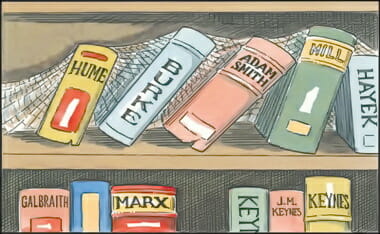
Millian vs Marxian Educational Goals | Jon Haidt
Rapid change… is the goal:
“Two incompatible sacred values in American universities” Jon Haidt, Hayek Lecture Series
On October 6, 2016, Professor Jonathan Haidt gave a Hayek Lecture at Duke. The event was co-sponsored by the programs in the History of Political Economy (HOPE), Philosophy, Politics, & Economics (PPE), and American Values and Institutions (AVI). The event was open to the public, but also served as a guest lecture in Professor Jonathan Anomaly’s PPE course.
Professor Haidt argues that conflicts arise at many American universities today because they are pursuing two potentially incompatible goals: truth and social justice. While Haidt thinks both goals are important, he maintains that they can come into conflict.
According to some versions of social justice, whenever we observe a disparity of outcomes between races, genders, or other groups, we should infer that injustice has been done. Haidt challenges this view of social justice and shows how it sometimes leads to violations of truth, and even justice.
Haidt concludes that universities should be free to pursue whatever goals – truth or social justice – they want, but that they should make it clear which of these two goals is their “telos” – their highest purpose. He ends with a discussion of his initiative, HeterodoxAcademy.org, to bring more viewpoint diversity to universities in order to improve research and learning.
The fuller article is worth your time – via Michael Nayna at the PROCESS:
…Haidt used two quotes to exemplify the opposing perspectives, the first from liberal philosopher John Stuart Mill.
“He who knows only his own side of the case knows little of that. His reasons may be good, and no one may have been able to refute them. But if he is equally unable to refute the reasons on the opposite side, if he does not so much as know what they are, he has no ground for preferring either opinion…
… he must know them (opposing opinions) in their most plausible and persuasive form.”
– John Stuart Mill, On Liberty
This quote reflects a liberal arts perspective. One that considers the discovery of truth as primary and is more concerned with accuracy than what’s to be done with the findings.
Embedded in this spirit of curious humility is a belief that objective reality exists and is accessible to all inquiring minds as long as they’re willing and able to overcome their subjective biases.
We recognize research conducted in this Millian disposition as scientific, with rigorous empirical methods, the development of testable hypotheses, and systematic observation, all being reflections of a striving toward the reduction of subjective bias.
Haidt contrasts this Millian perspective with that of Karl Marx, the father of communism, who was notoriously pragmatic in his pursuit of revolution.
“The philosophers have only interpreted the world, in various ways. The point, however, is to change it.”
– Karl Marx, Eleven Theses on Feuerbach
This quote reveals an activist’s disposition that regards the effect of thought as its primary purpose. Embedded in this perspective is an eagerness to impose one’s will on the world and it would likely give rise to an eye roll if confronted with Millian appeals to dispassionate analysis….
A related couple posts:
